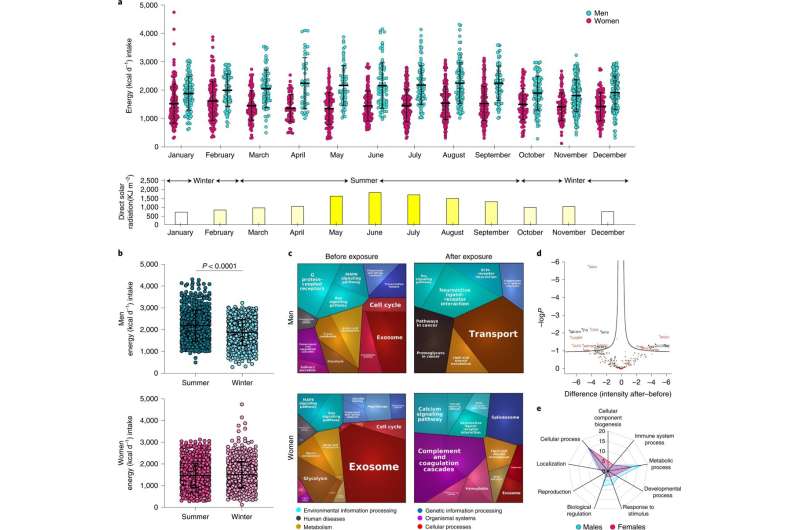July 12, 2022 report
Sunlight exposure found to trigger increased eating in men

A team of researchers affiliated with several institutions in Israel, working with colleagues from Columbia University in the U.S. and the Institute for Diabetes and Obesity in Germany, has found that exposure to more sunlight over the summer leads to an increase in eating—but only in men. In their paper published in the journal Nature Metabolism, the group describes their study of data obtained from an Israeli health survey. Carlos Dieguez and Ruben Nogueiras with the University of Santiago de Compostela, published a News & Views piece in the same journal issue, outlining factors that lead to environmental mortality and the work done by the team in this new effort.
Prior research has shown that exposure to sunlight provides humans with benefits, such as instigating the production of vitamin D, and disadvantages, such as skin damage and a higher risk of skin cancer. In this new effort, the researchers found that it might do something else—make men hungrier.
The researchers were looking into the ways that sunlight can lead to skin cancer in mice when they noticed that the male mice seemed to grow hungrier when exposed to UV light. Intrigued, they wondered if the same might be true with humans. To find out, they obtained data from a governmental questionnaire sent to people all across Israel enquiring about a host of health and nutritional issues. They found that men tend to eat more during the summer months than during the other seasons. More specifically, they found that men consumed approximately 15% more calories during the summer, which they attributed to more exposure to sunlight. Food intake for women did not change.
The researchers took a closer look at the hormone ghrelin—commonly known as the hunger hormone. Prior research has shown it is produced by cells in the stomach, and sometimes in the pancreas, small intestine and brain. It is transported through the bloodstream, activating neurons in the hypothalamus, which reacts by creating the sensations of hunger. The hormone has also been found to impact other brain areas, as well, such as the amygdala, which can stimulate the production of dopamine. Ghrelin levels are known to rise both during periods of hunger and just before a meal is consumed.
Testing in mice showed ghrelin levels rising in male mice exposed to UVB radiation. Secretion of the hormone was also discovered in skin samples obtained by male human volunteers who were exposed to UV light in the lab. "In females, estrogen interferes with the p53–chromatin interaction on the ghrelin promoter, thus blocking ghrelin and food-seeking behavior in response to UVB exposure," stated the researchers.
More information: Shivang Parikh et al, Food-seeking behavior is triggered by skin ultraviolet exposure in males, Nature Metabolism (2022). DOI: 10.1038/s42255-022-00587-9
Carlos Dieguez et al, Sun exposure stimulates appetite in males, Nature Metabolism (2022). DOI: 10.1038/s42255-022-00592-y
© 2022 Science X Network


















